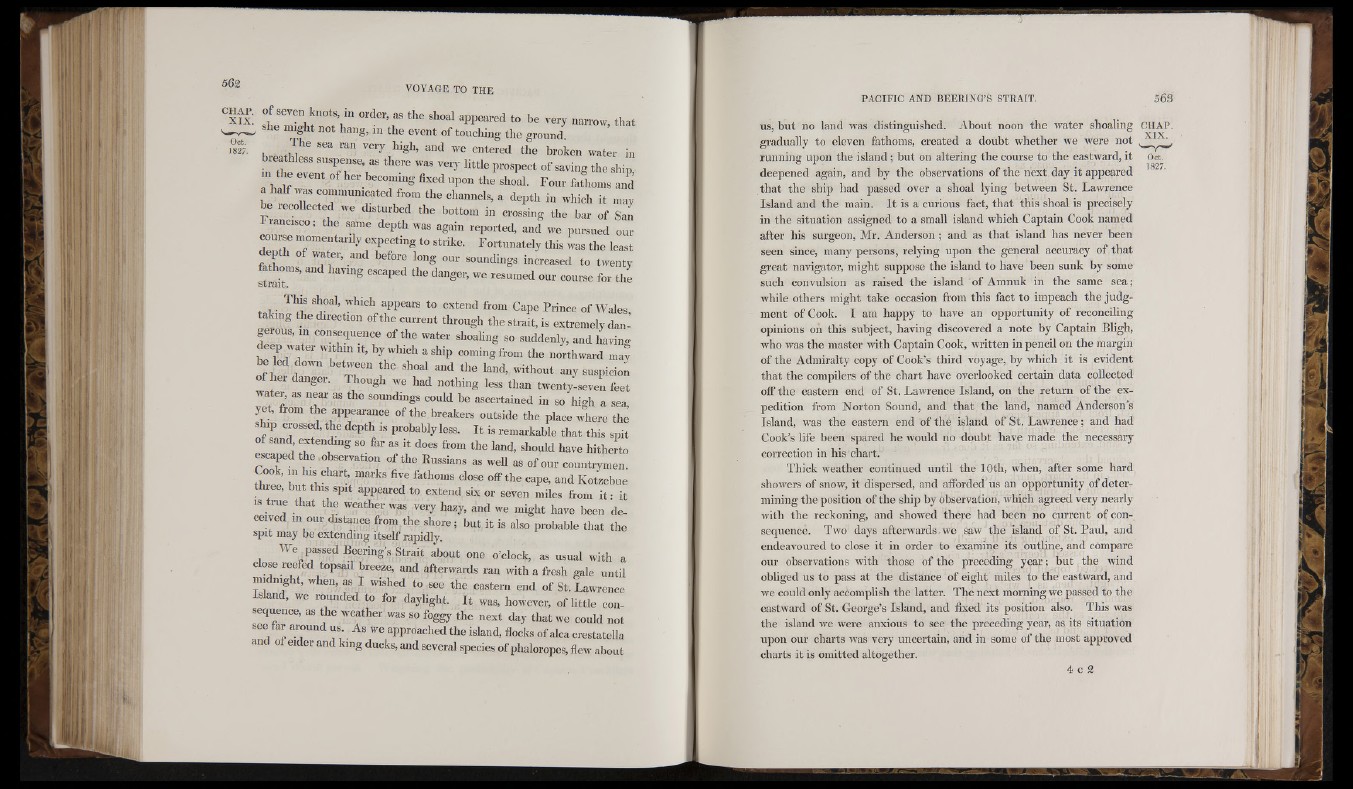
.----- -he might not hang, in the event of touching the ground.
Oct.
1827.
Ih e sea ran very high, and we entered the broken water in
breathless suspense, as there was very little prospect of saving the ship
1 the event of her becoming fixed upon the shoal. Four fothoms and
a half was commnnicated from the channels, a depth in which it may
be lecollected we disturbed the bottom in crossing the bar of San
Fiancisco; the same depth was again reported, and we pursued onr
course momentarily e.xpecting to strike. Fortunately this was the least
depth of water, and before long our soundings increased to twenty
fathoms, and having escaped the danger, we resumed our course for the
Strait.
. appears to extend from Cape Prince of Wales
taking the direction ofthe current throngh the strait, is extremely dan-’
gerons, in consequence ofth e water shoaHiig so suddenly, and havin«
deep water within it, by which a ship coming from the northward mav
be led down between the shoal and the land, without any suspicio;
of her danger. Though we had nothing less than twenty-seven feet
water, as neai- as the soundings could be ascertained in so hi«h a sea
yeh from the appearance of the breakers outside the place where thè
ship crossed, the depth is probably less. It is remarkable that this spit
of sand extending so far as it does from the land, should have hitherto
escaped the observation ofth e Eussians as well as of our countrymen.
Cook, in his chart, marks five fathoms close offthe cape, and Kotzebue
Aiee, but this spit appeared to extend six or seven miles from i f it
IS true that the weather was very hazy, and we might have been deceived
in our distance from the shore ; but it is also probable that the
spit may be extending itself rapidly.
We passed Beering s Strait about one o’clock, as usual with a
close reefed topsail breeze, and afterwards ran with a fresh gale until
midnight, when, as I wished to see the eastern end of St. Lawrence
Island, we rounded to for daylight. It was, however, of little consequence,
as the W'eather was so foggy the next day that we could not
see far around us As we approached the island, flocks of alca crestatella
an of eider and king ducks, and several species of phaloropes, flew about
US, but no land was distinguished. About noon the water shoaling C H A P .
gradually to eleven fathoms, created a doubt whether we were not . .
running upon the island; but on altering the course to the eastivard, it O c t
deepened again, and by the observations of the next day it appeared
that the ship had passed over a shoal lying between St. Lawrence
Island and the main. It is a curious fact, that this shoal is precisely
in the situation assigned to a small island which Captain Cook named
after his surgeon, Mr. Anderson ; and as that island has never been
seen since, many persons, relying upon the general accuracy of that
great navigator, might suppose the island to have been sunk by some
such convulsion as raised the island of Amnuk in the same sea;
while others might take occasion from this fact to impeach the judgment
of Cook. I am happy to have an opportunity of reconciling
opinions on this subject, having discovered a note by Captain Bhgh,
who was the master with Captain Cook, iviltten in pencil on the margin
of the Admiralty copy of Cook’s third voyage, by w'hich it is evident
that the compilers of the chart have overlooked certain data collected
off the eastern end of St. Lawrence Island, on the return of the expedition
from Norton Sound, and that the land, named Anderson’s
Island, was the eastern end of the island of St. Lawrence; and had
Cook’s life been spared he would no doubt have made the necessary
correction in his chart.
Thick weather continued until the 10th, when, after some hard
shoivers of snow, it dispersed, and afforded us an opportunity of determining
the position of the ship by observation, which agreed very nearly
w ith the reckoning, and showed there had been no current of consequence.
Two days afterwards we saw the island of St. Paul, and
endeavoured to close it in order to examine its outhne, and compare
our observations with those of the preceding year; hut the wind
obhged us to pass at the distance of eight miles to the eastward, and
we could only accomplish the latter. The next morning we passed to the
eastivard of St. George’s Island, and fixed its position also. This was
the island w’e were anxious to see the preceding year, as its situation
upon our charts ivas very uncertain, and in some of the most approved
charts it is omitted altogether.